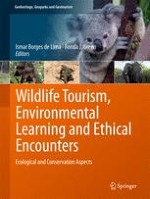2017 | OriginalPaper | Buchkapitel
6. Wildlife Tourism Safaris, Vehicle Decongestion Routes and Impact Mitigation at Chobe National Park, Botswana
verfasst von : Naomi Moswete, Kenosi Nkape, Mpho Tseme
Erschienen in: Wildlife Tourism, Environmental Learning and Ethical Encounters
Aktivieren Sie unsere intelligente Suche, um passende Fachinhalte oder Patente zu finden.
Wählen Sie Textabschnitte aus um mit Künstlicher Intelligenz passenden Patente zu finden. powered by
Markieren Sie Textabschnitte, um KI-gestützt weitere passende Inhalte zu finden. powered by
